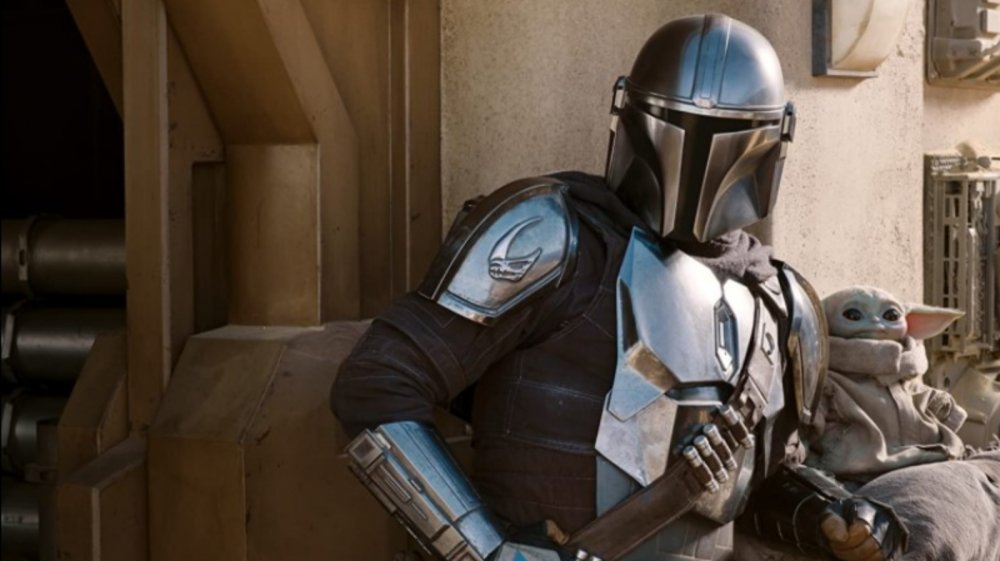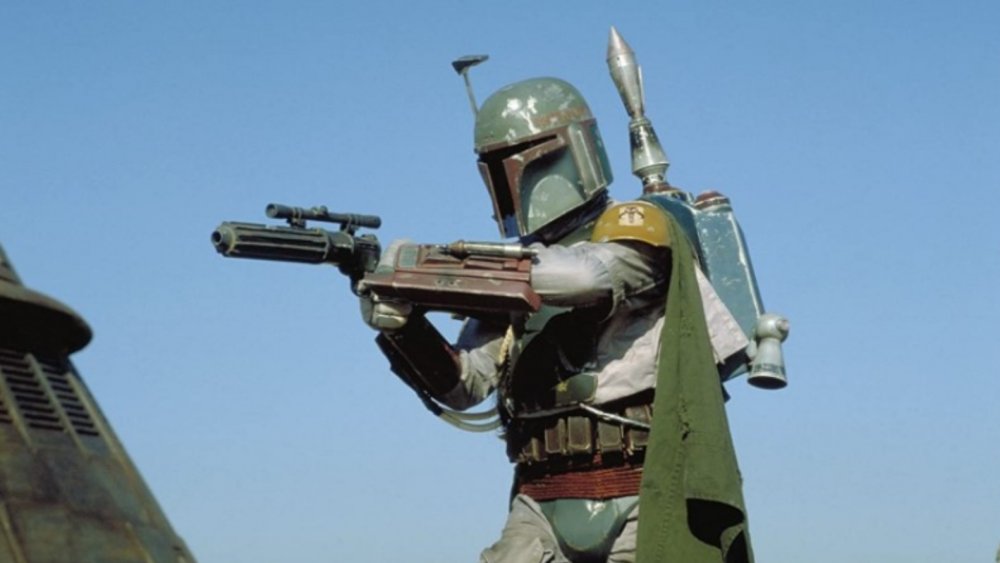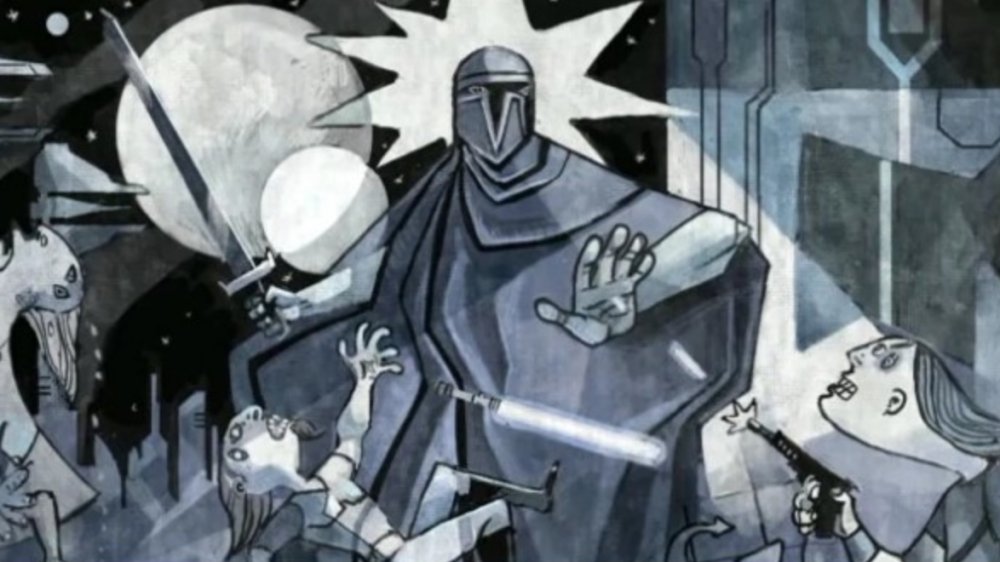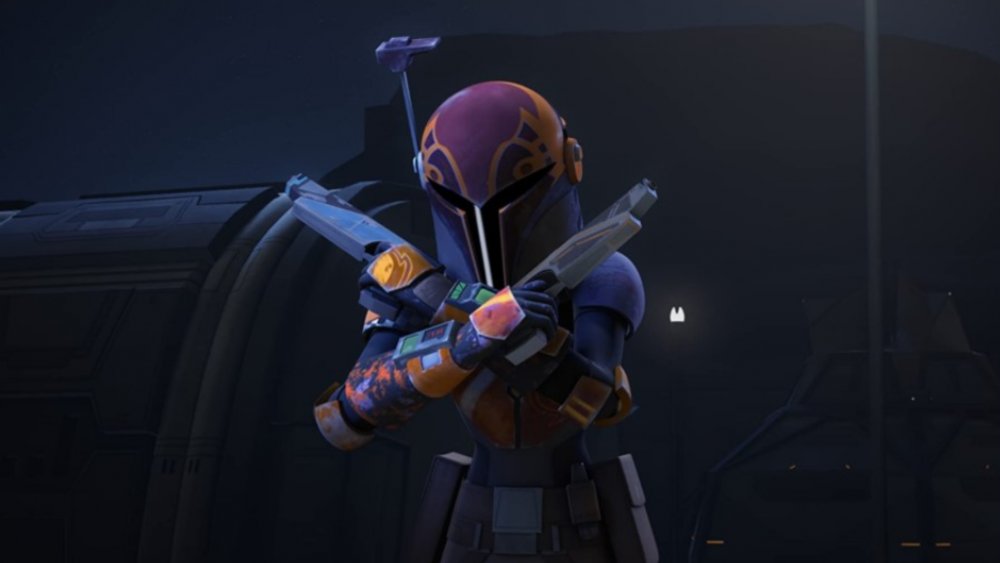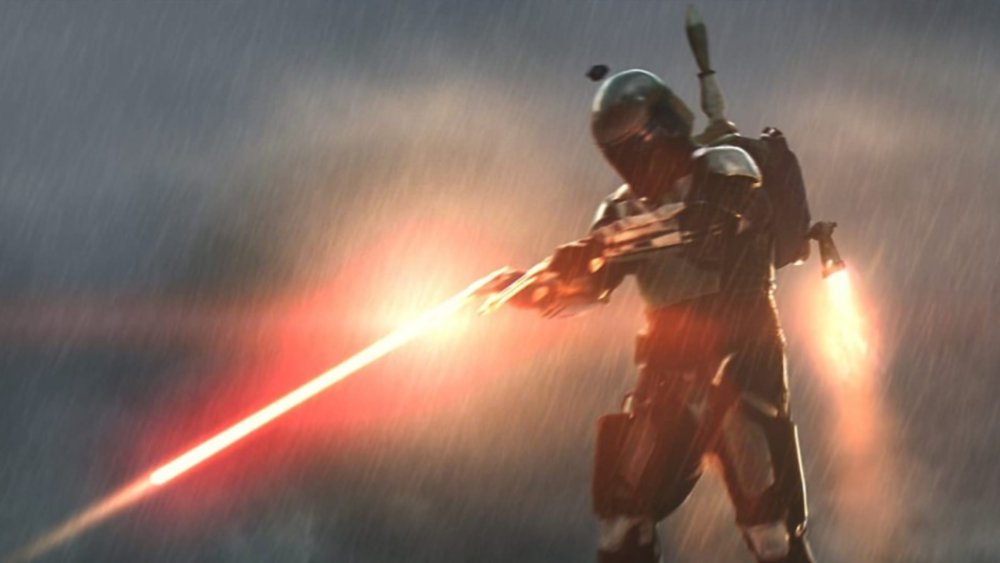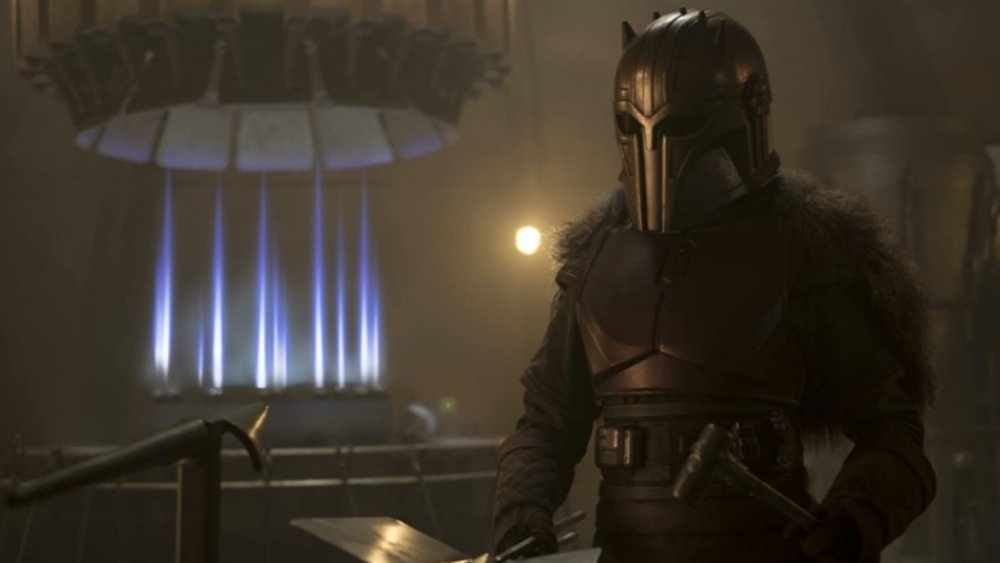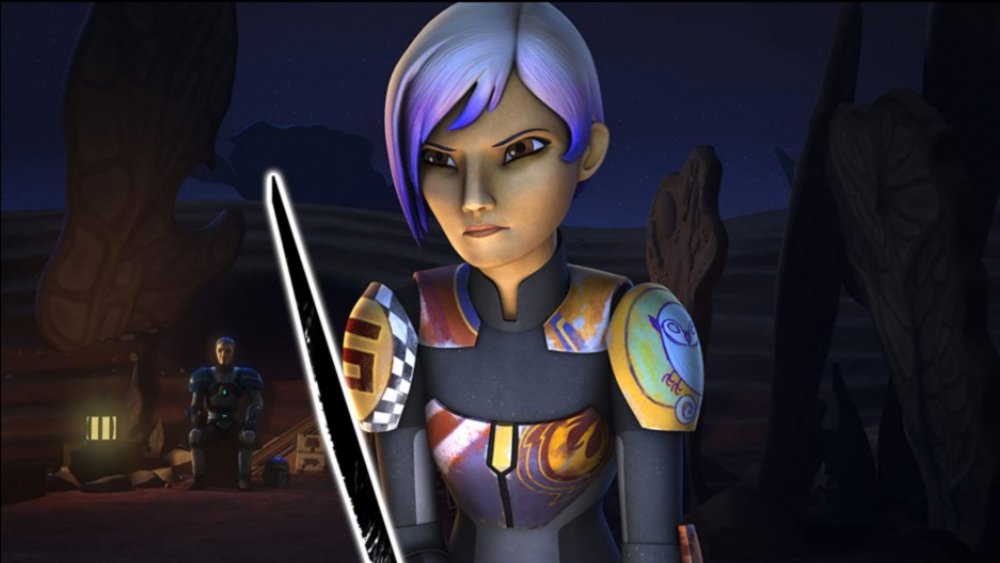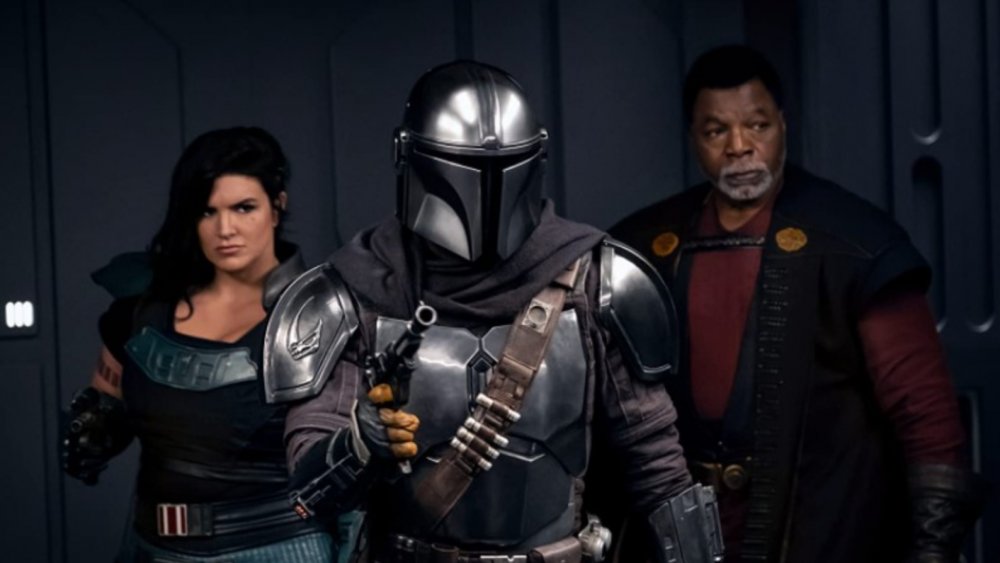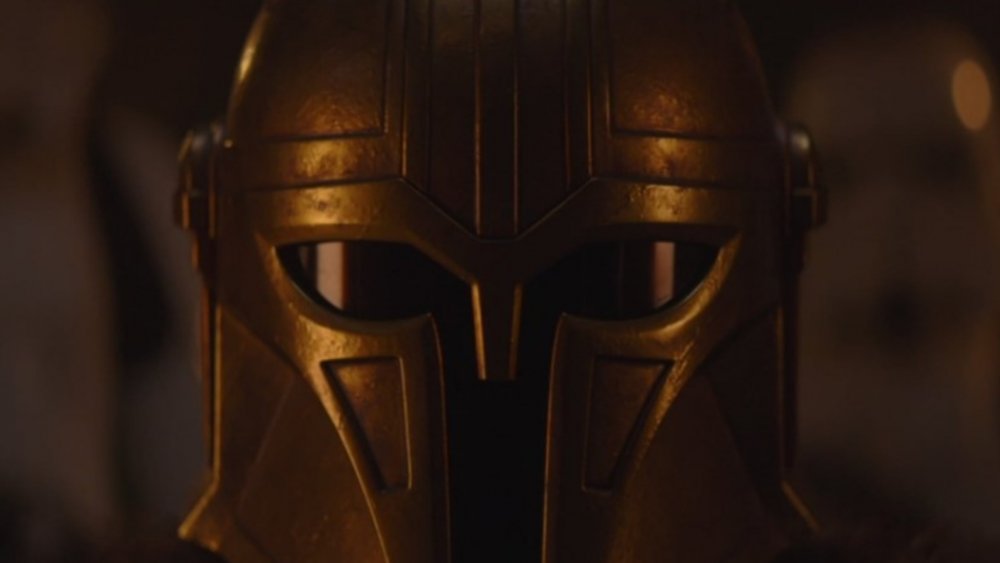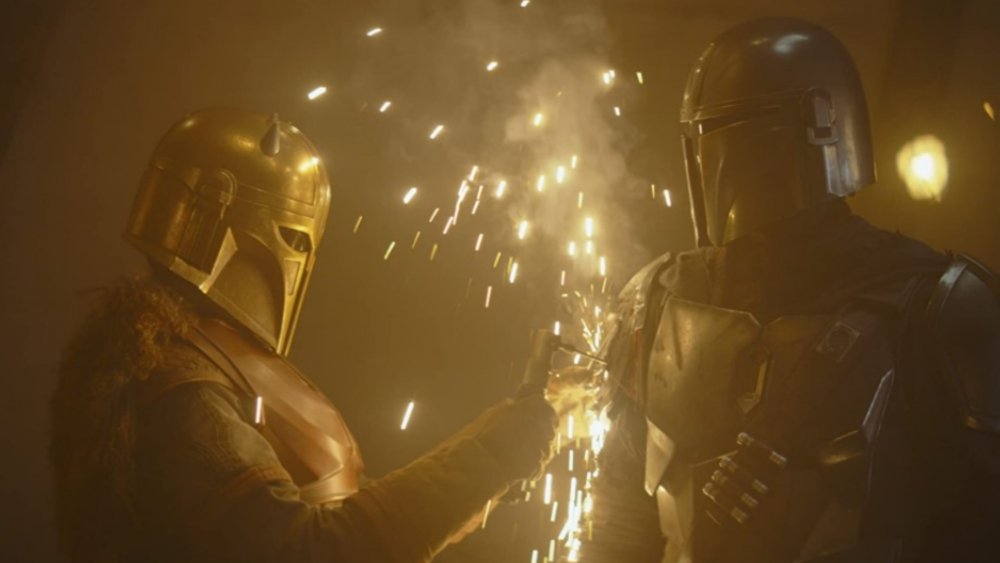The History Of Mandalorian Armor Explained
You might not guess it from the silhouette, but a Mandalorian's armor is as unique as their fingerprints. Handed down through generations, armor is a defining trait of the Mandalorian people and their culture — and it's definitely one of their most recognizable attributes.
During its first season, The Mandalorian on Disney+ showed off lots of armor, thanks to "The Tribe," the group of Mandalorians living in hiding after the fall of the Empire on the planet Nevarro. Those new to the Star Wars universe and longtime fans both learned several things about Mandalorians and their armor — and saw a few different looks for protagonist Din Djarin (Pedro Pascal, Game of Thrones, Wonder Woman 1984), a.k.a. Mando.
Mando might explain his armor with the simple phrase, "This is the Way." But for the more curious, let's unpack some of the history of Mandalorian armor and its special features, starting with the idea that clothes don't make the man, woman, or Mandalorian. As Star Wars tie-in novelist Karen Traviss once noted: "Armor is simply a manifestation of an impenetrable, unassailable heart." (Spoilers ahead!)
A warrior is more than his armor
The Mandalorians are a nomadic people, but they're not one species. Anyone can be a Mandalorian if they practice the tenets of their faith, which Din Djarin explains during The Mandalorian's first season, relating how the group raised him after battle droids killed his parents. Before the Disney+ show, Boba Fett was one of the most well-known Mandalorians in the Star Wars universe, but although he wore Mandalorian armor, he didn't really grow up in the culture and therefore is not a true Mandalorian, according to Time magazine.
Because Mandalorians are a warlike people who often act as mercenaries, wearing armor is one of the Six Actions central to their identity, Traviss says. The other five are speaking the Mandalorian language, contributing to the welfare of their clan, defending themselves and their families, raising their children as Mandalorians, and rallying around the sole leader of their people (the Mand'alor) when asked.
Yet even though their armor is a central part of their culture, Mandalorians like reminding each other that what's inside matters most. "A warrior is more than his armor" is one popular Mandalorian saying, Traviss wrote.
From the days of Mandalorian crusaders
Early Mandalorian armor appeared during season 2 of the animated series Star Wars: The Clone Wars. The episode "The Mandalore Plot" showed a mural depicting ancient Mandalorian crusaders wearing helmets over their cloaks as they fought the Jedi Knights. To battle the Force powers of the Jedi, the Mandalorians modified their fighting style and weaponry.
"The Mandalorian-Jedi War that I have in my mind is very much derived from the oldest style of thinking of Mandalorians, which was that their weapons, their arsenal, their technology had a massive increase once they collided with the Jedi and found these Force-wielding people that had abilities they didn't understand," Clone Wars director Dave Filoni once told ComicBook.com. "Their armor is a reaction to the Jedi, and I've always believed that because that seemed to be something that would be in the DNA of the Joe Johnston designs of them as super commandos." Johnston, who directed Captain America: The First Avenger and The Rocketeer, was a concept artist on the original Star Wars trilogy.
Incidentally, Filoni became the showrunner on the animated series Star Wars Rebels and now is a writer on The Mandalorian. As for that mural, the Star Wars wiki notes that Filoni said on an episode commentary for "The Mandalore Plot" that the artwork was meant to resemble Pablo Picasso's 1937 painting Guernica, considered one of the most powerful anti-war paintings in history.
Keep it under your hat -- or helmet
Both Star Wars: The Clone Wars and Star Wars Rebels delved into other Mandalorian armor history tied to the Mandalorian Civil War, which split the group into the pacifist New Mandalorians and the militant Death Watch. Although many fans would recognize a Mandalorian by their armor, specifically the full-face helmet with T-shaped visor, this schism revealed other variations, particularly in the helmets. For instance, the female warriors of Death Watch, known as the Nite Owls, wore helmets with eye slits that tilt up like an owl's. Sabine Wren, the Star Wars Rebels character who is a Mandalorian warrior, demolitions expert, and graffiti artist, has a Nite Owls helmet that she inherited.
Speaking of Sabine, she didn't follow the strict helmet rules that Din Djarin outlines on The Mandalorian — namely, that he can't remove his helmet in front of other people, or his vow is broken and he's no longer part of his tribe. Sabine often went without her helmet, even though she usually wore her armor. "My armor is like my second skin," she once said. "I'm being serious. Sometimes I totally forget I even have it on, and I fall asleep in it."
A well-stocked arsenal
A Mandalorian's armor includes a lot of accessories. The helmet, for instance, has a comlink with an antenna. It also includes night vision, a tactical display, facial and vocal recognition, a fingerprint scanner, video recording, links to vehicles and weapons, and flight controls for the jetpacks that Mandalorians use to be more maneuverable in battle.
In The Mandalorian, Din Djarin receives a jetpack from the Armorer at the end of season 1, which he uses to fight against Moff Gideon (Giancarlo Esposito). Mando fares pretty well, considering that he's still learning the controls, unlike the undignified trajectory of Boba Fett in Star Wars: Return of the Jedi.
One key part of a Mandalorian's arsenal is the vambrace, a wrist gauntlet chock-full of various weaponry, including a 25-meter-long retractable fibercord, flamethrower, energy shield projector, trackers, laser targeting sights, launchers for tranquilizing or explosive darts, a mini rocket launcher, motion detectors, repulsors, a communications system, and a touchscreen display.
Bring on the beskar
Next to its well-known silhouette, Mandalorian armor is also known for its toughness, thanks to beskar, also called "Mandalorian iron" or "Mandalorian steel." Beskar protects against blaster shots as well as lightsaber strikes, but it's also lightweight, allowing the wearers to be much more agile than Tony Stark busting out of a cave in his Mark I suit in 2008's Iron Man.
Beskar has such remarkable strength because of both its natural properties and Mandalorian metalworking techniques, Traviss wrote. On The Mandalorian, Din Djarin causes a stir when a client pays him in bars of beskar. The Armorer (Emily Swallow) remembers how the rare metal could be mined only on their home planet of Mandalore and likely was stolen during the "Great Purge."
In The Mandalorian's first episode, the Armorer uses a bar of beskar to forge a new pauldron, or shoulder plate, for Mando. He gets more upgrades later because of a hefty payment of beskar.
Color us impressed
The colors and markings on Mandalorian armor signify many things, according to Traviss. These can be as specific as their individual clans or family groups, or they can express "more ephemeral concepts such as state of mind or a particular mission," she noted in Star Wars Insider. Black represents justice, while sand-gold represents a quest for vengeance.
That said, Mandalorians also decorate their armor according to taste. They'll repaint their armor if they change clans or if they're on a particular task. Sabine Wren, for instance, often changed her armor's markings much like she changed her hair color, adding a prominent insignia in her Starbird design, a precursor to the emblem of the Rebel Alliance.
Blue and green are popular armor colors for Mandalorians, who like to be conspicuous, Traviss wrote, referencing another Mandalorian saying: "It's one thing to see us coming, and another to do something about it."
Take what you can carry
Mandalorian armor doesn't just provide protection — it's also an heirloom because beskar can last for hundreds of years. As Sabine Wren once said, "The armor I wear is 500 years old. I reforged it to my liking, but the battles, the history, the blood all lives within it. And the same goes for every Mandalorian."
Traviss explained in Star Wars Insider that as a nomadic people, Mandalorians frugally invested much of their wealth into their armor and weapons. This was certainly practical because they could take their earnings with them.
Early in The Mandalorian, Mando receives a large payment of Beskar after delivering the Child — the most adorable version of a Yoda-like being in the galaxy — to his mysterious Imperial client (played by renowned director Werner Herzog). After Mando presents the beskar to the Armorer, she suggests that she can craft a full cuirass for him, plus "whistling birds," a type of mini-missile. The excess he donates to the foundlings, the orphaned children that the Mandalorians protect.
Catching up afterward with Greef Karga (Carl Weathers), head of the Bounty Hunters' Guild, Mando draws several stares over his shiny new threads, but he's really just following the investment strategy of ancient Mandalorians. Besides, Karga notes, the grumblers are just jealous they didn't get all that loot.
Getting personal
His distinctive beskar armor is one of Mando's few custom touches. (We'll get to the Mudhorn signet on his right shoulder in a moment.) Mandalorians love personalized armor.
Sabine Wren embraced this part of Mandalorian culture throughout Star Wars Rebels, and not just through her signature designs like the black-and-white pattern of a holochess board on her shoulder. Rebels fans know that she kept the armor's insulating body glove but stripped away a lot of other pieces for maximum mobility. She also upgraded her helmet's electronics, although she used the video- and image-recording capabilities to capture her artwork much more than the targeting viewfinder.
On The Mandalorian, the Armorer has strikingly distinctive armor, from the fur across the backplate to the shape of her eyes on her helmet. Polygon notes that her helmet also appears to have Zabrak horns, which could be a reference to Darth Maul, a Zabrak who briefly ruled Mandalore and headed the Death Watch on Star Wars: The Clone Wars.
A clan of two
Mandalorian armor often has sigils, or symbols painted on the chestplate or helmet indicating their lineage, allegiance, or even awards for bravery, according to Traviss. The armor also can have a signet specifying the wearer's particular clan.
When The Mandalorian begins, Din Djarin has no signet. Even though he was adopted by the Mandalorians as an orphan, was trained as a warrior, and joined their tribe, he starts the first season as a classic Western lone-wolf archetype. That changes once he meets the Child, who uses his Force powers to help Din defeat a charging Mudhorn, a creature that resembles a gigantic rhino. When the Armorer suggests that he has earned the Mudhorn as a signet for felling the creature, he declines. "It wasn't a noble kill," he says.
But once Din has a change of heart and retrieves the Child from the Imperials who want his power, the Armorer decides that Din is worthy of such an honor. She forges a Mudhorn signet for him and instructs him to take care of the green foundling and to return the Child to his own kind if possible. In the meantime, she says, "You are a clan of two."
If you're looking for more history, see where The Mandalorian fits into the Star Wars timeline.
